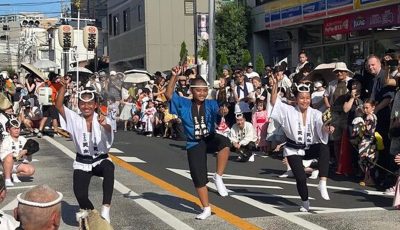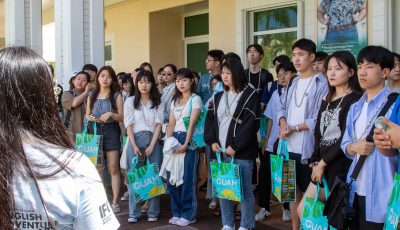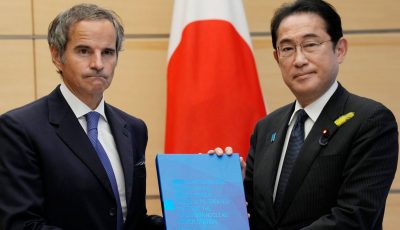Soudelor’s tangan-tangan
The story is common enough that though we can quibble on the details the whole is believable. The tangan-tangan that dominates our “forest” landscape is hardly native to the islands.
It is said that after the Marianas raised sufficient sugar for Japan before World War II, Hawaiian sugar business did not welcome any competition so instead of having the Marianas revert to the manicured sugar cane fields Japan had, the navy flew and dropped bushels of tangan-tangan seeds instead, and STaR (Saipan, Tinian, and Rota) has been overwhelmed with tangan-tangan ever since.
Soudelor raked all the trees but also revealed the fragility of the tangan-tangan tree and perhaps it is time to reevaluate their growth in our forests. One of the residents in my complex, looking out to the hills toward Tapuchao commented that she could actually see beautiful houses on the slopes without cover of the tangan-tangan.
Tangan-tangan is a fast growing tree, doubling height of six feet easily within six months. The young leaves feed livestock, and the tree barks are gathered for firewood, sometimes charred for charcoal, though that is not one of its virtues. Its bark is unlike the hardwood needed to make good charcoal.
But it is now 70 years since the little boy and fat man were flown out of Tinian to usher us to the atomic age. Also, sugar has left the slopes of Mauna Koa, and the creole families that took over have since divested themselves of real estate; the ukulele sounds at Kamehameha highway and Kalakaua boulevard have become part of the local scene again.
Nippon’s sugarcane field of the Marianas never gained productive prominence again as the islands’ value was pegged on its military strategic position to Uncle Sam’s interests. The islands were neglected during the Cold War as containment policy in the Far East was fought through subservient South Korea and compliant Japan, focusing more on the Russians and only incidentally on China, perceived to be too weak to feed its people on its agrarian economy.
That changed when the bamboo curtain opened up to Walmart; manufacturing lowered both the prices and quality of commodities around the world. The Enfield was never fired for China had the fiscal example of Uncle Sam to follow, and Obama did not want a shooting gallery.
The devaluation of the global currency left the Federal Reserve’s power to print money on the basis of financial preeminence. The U.S. rode on its financing of WWII loans as overseas payments to the local economy was inflationary so it created the World Bank-International Monetary Fund to retain the returns from the Marshall Plan, used to align needy nations while containing inflation in the U.S. America had its cake, and ate it, too!
With the U.S. appearing altruistic, it nonetheless utilized 80 percent of the world’s resources in a non-replicable lifestyle that justified the Malthusian analysis of not enough resources to go around for all when production lags behind population growth.
China became the world’s cheap production line but avoided inflation by buying into government bonds and securities of its trading partners. It urbanized, cut down on population growth, and bought Treasury bills. The enemy to be contained emerged with a front seat at the stock exchange. China has its cake, but we do not think it should eat it, too!
China saw its externally seeded tangan-tangan that made its economy huge but easily at the mercy of foreign investments in Shanghai, Shenzhen, and Xiang Gang (HK). So Beijing decided to manage its fiscal terrain by investing in public works that saw infrastructure in rail and highway, and the first maglev between Beijing and Shenyang that will cut a normally four-hour rapid rail travel into two.
Then it created new communities on the premise that if the “field of dreams” were built “they would come” (I reside in a “ghost town” where a fourth of the buildings are occupied but the rest are idle, yet the whole development is fully subscribed to and sold out).
Presently, it roots corrupt practices out of its ranks. “You can’t be rich and work for the government at the same time,” is my favored Xijinping quote. Media guess which of the charges of corruption is politically motivated, or who is targeted by “draconian measures to ensure CPC stranglehold on the nation.” Yo! Check who sits in the Politburo’s Committee of Seven!
What makes BSI’s casino pitch on Saipan viable is a chastened Aomen (Macau) that has the Portuguese playing outside the purview of Lisbon (as long as they go to confession after; China has no restitutium in integrum for wayward officials). The anti-mainland sentiments of forces in Manila, Kuala Lumpur, and Singapore drive earnest renminbi away. The CNMI’s historic tolerance of uncouth visitors to its relatively pristine shores is making the place a gaming capital of the Pacific!
Soudelor is to be thanked for leaving bare the foothills of Saipan so we can re-decide our habitat, the tangan-tangan in our landscape, and perhaps, also the tangan-tangan of our minds, but most importantly, those in our souls!



























